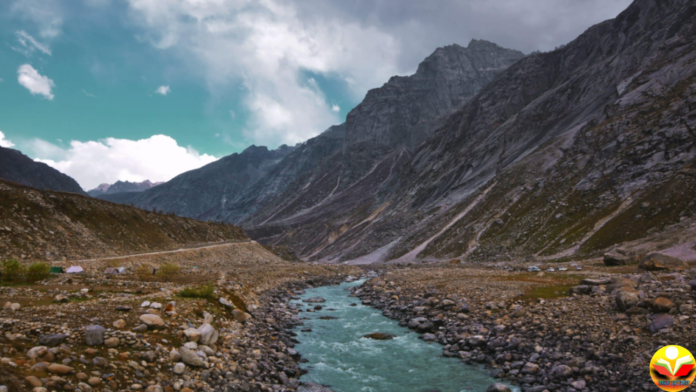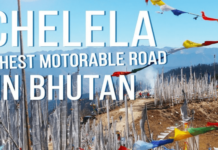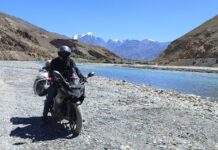Nestled in the rugged and remote corners of Himachal Pradesh, India, Spiti Valley is a traveler’s paradise. This high-altitude desert, surrounded by the majestic Himalayan mountains, offers a unique blend of breathtaking landscapes, ancient monasteries, and a vibrant local culture. Planning a trip to Spiti Valley can be an exhilarating experience, but it requires careful preparation due to its remote location and challenging terrain. In this comprehensive guide, we’ll walk you through every aspect of planning your journey to Spiti Valley, ensuring that you have a safe and memorable adventure.
1. Location and Geography: Spiti Valley is situated in the northeastern part of Himachal Pradesh, India, bordering Tibet. It lies at an average altitude of around 12,500 feet (3,810 meters) above sea level, making it a high-altitude desert. Surrounded by the Greater Himalayas and the Pir Panjal range, Spiti offers stunning vistas of barren mountains, deep gorges, and pristine rivers.
When to Visit: Spiti Valley is primarily accessible during the summer months, from May to October. The weather is relatively pleasant during this period, with temperatures ranging from 0°C to 20°C (32°F to 68°F). Winter, from November to April, is harsh and not recommended for tourism due to heavy snowfall and extreme cold.
When to Visit: Spiti Valley is primarily accessible during the summer months, from May to October. The weather is relatively pleasant during this period, with temperatures ranging from 0°C to 20°C (32°F to 68°F). Winter, from November to April, is harsh and not recommended for tourism due to heavy snowfall and extreme cold.
Why Visit Spiti Valley: Spiti Valley attracts travelers for various reasons:
- Natural Beauty: The stark and surreal landscapes, including snow-clad peaks, vast valleys, and clear blue skies, are a photographer’s dream.
- Cultural Richness: Spiti is home to ancient Buddhist monasteries, providing a glimpse into Tibetan culture and spirituality.
- Adventure: The challenging roads, high-altitude treks, and opportunities for camping and stargazing make it an adventurer’s paradise.
- Remote Serenity: Spiti offers a chance to disconnect from the world and immerse yourself in the tranquility of a remote mountain region.
Now that you have a brief introduction to Spiti Valley, let’s delve deeper into the details of planning your trip.
2. Setting Your Budget
Before you start planning your Spiti Valley trip, it’s essential to determine your budget. Spiti can be experienced on a range of budgets, from backpacker-friendly to more luxurious. Here are some cost factors to consider:
Cost Factors to Consider:
- Transportation: Your biggest expense will likely be getting to and from Spiti Valley. This includes flights, buses, or taxis to reach Shimla or Manali, as well as the cost of internal transportation within Spiti.
- Accommodation: The type of accommodation you choose will significantly impact your budget. Options range from budget guesthouses and homestays to more expensive hotels and resorts.
- Food: Dining out in restaurants can add up, so consider your food budget. You can save money by eating at local eateries or preparing your meals if camping.
- Permits and Entrance Fees: Depending on your nationality, you may need to pay for Inner Line Permits (ILPs) and entrance fees to monasteries and other attractions.
- Activities and Excursions: Budget for activities such as trekking, guided tours, and any adventure sports you plan to try.
- Shopping and Souvenirs: If you want to purchase local handicrafts or souvenirs, allocate some funds for shopping.
- Emergency Fund: Always have a contingency fund for unexpected expenses or emergencies.
Budget-Friendly Options:
- Homestays: Staying with local families in Spiti is not only budget-friendly but also provides an authentic cultural experience.
- Cook Your Meals: If you’re on a tight budget, consider staying in accommodations with kitchen facilities and preparing your meals.
- Public Transportation: Opt for local buses or shared taxis for cost-effective transportation within Spiti.
- Group Travel: Traveling with a group can help reduce costs, as you can share expenses for accommodation and transportation.
- Prioritize Activities: Choose a few must-do activities or excursions and prioritize those over less important ones to stay within budget.
Having a clear budget in mind will guide your choices throughout the planning process and help you make informed decisions about how to allocate your funds effectively.
3. Creating an Itinerary
Your Spiti Valley itinerary will be the roadmap for your adventure. It’s essential to plan your route, decide on the places you want to visit, and estimate how many days you’ll spend in each location. Here are some key aspects to consider:
Popular Destinations in Spiti:
- Kaza: The administrative headquarters of Spiti Valley, Kaza is a popular base for exploring the region. It offers various accommodations, restaurants, and access to nearby attractions.
- Key Monastery (Key Gompa): This iconic Buddhist monastery, perched on a hilltop, is known for its stunning views and serene ambiance.
- Dhankar Monastery: Visit this ancient monastery with a precarious location atop a high cliff.
- Tabo: Known as the “Ajanta of the Himalayas,” Tabo houses one of the oldest functioning monasteries in the region.
- Chandratal Lake: A high-altitude lake surrounded by mountains, it’s a trekking and camping paradise.
- Kunzum Pass: A high mountain pass offering breathtaking panoramic views.
- Pin Valley: Explore this wildlife sanctuary known for its unique landscapes and wildlife.
Recommended Duration of Stay: A typical Spiti Valley trip ranges from 7 to 14 days, depending on your interests and how thoroughly you want to explore the region. Here’s a sample 10-day itinerary:
- Day 1-2: Reach Shimla or Manali and acclimatize.
- Day 3: Travel to Reckong Peo or Kalpa (en route to Spiti).
- Day 4-6: Explore Kaza, Key Monastery, Dhankar Monastery, and nearby attractions.
- Day 7: Head to Tabo and visit the Tabo Monastery.
- Day 8-9: Trek to Chandratal Lake (or visit by vehicle).
- Day 10: Return journey or explore more of Spiti Valley.
Customizing Your Itinerary: Customize your itinerary based on your interests. If you’re into trekking, allocate more time for hikes. If you’re a culture enthusiast, spend extra days at monasteries and attending local festivals. Flexibility in your itinerary is key to enjoying your trip to the fullest.
4. Choosing Travel Companions
Deciding whether to travel solo or with companions is an important consideration for your Spiti Valley adventure. Each option has its pros and cons:
Solo Travel:
- Freedom: You have complete control over your itinerary, allowing you to change plans on a whim.
- Self-Discovery: Solo travel can be a transformative experience, allowing you to learn more about yourself.
- Connect with Locals: You may find it easier to connect with locals and immerse yourself in the culture when traveling alone.
- Loneliness: Solo travel can sometimes be lonely, especially in remote areas with limited interaction.
- Safety Concerns: Safety can be a concern, especially in challenging terrain or if you fall ill.
Group Travel:
- Safety: Traveling in a group can provide safety and support, particularly in case of emergencies.
- Shared Expenses: Costs for accommodations, transportation, and guides can be shared among group members, potentially reducing expenses.
- Social Interaction: You’ll have built-in companions to share experiences and make memories with.
- Less Flexibility: Group travel can be less flexible, as you’ll need to consider the preferences and schedules of others.
- Limited Personal Space: You may have less personal space and privacy when traveling with a group.
Choose the option that aligns with your personality, travel style, and comfort level. If you opt for solo travel, take necessary precautions for safety and ensure you’re well-prepared for the journey.
5. Transportation to Spiti Valley
Getting to Spiti Valley is an adventure in itself, as the region is remote and accessible via challenging mountain roads. The two primary starting points for Spiti Valley are Shimla and Manali.
Getting to Spiti Valley:
- Via Shimla: If you choose to start from Shimla, you’ll travel through Kinnaur District before reaching Spiti Valley. The route passes through Reckong Peo, Kalpa, and other scenic areas.
- Via Manali: The Manali route takes you over the famous Rohtang Pass and Kunzum Pass, offering stunning views along the way. Keep in mind that Rohtang Pass may be closed during winter and early spring due to heavy snow.
Preferred Starting Points: Shimla and Manali:
- Starting from Shimla: This route offers a gradual ascent and may help with acclimatization. You can take a bus or hire a taxi from Shimla to Reckong Peo or Kalpa, which are en route to Spiti Valley.
- Starting from Manali: The Manali route is more popular, especially among adventurers. You can hire a taxi or take a bus from Manali to Kaza, the main town in Spiti Valley.
Road Conditions and Challenges:
- Challenging Terrain: The roads to Spiti Valley are often narrow, winding, and prone to landslides, making them challenging to navigate. It’s crucial to have an experienced driver if you’re not driving yourself.
- Altitude Gains: The roads to Spiti involve significant altitude gains in a short time. Be prepared for altitude sickness, and acclimatize properly.
- Limited Facilities: Along the way, you’ll find limited facilities, such as gas stations and food stops. Stock up on essentials before starting your journey.
- Weather Considerations: Check road conditions and weather updates regularly, as road closures due to snow or landslides are common, especially during monsoon season.
When planning your trip, consider your level of comfort with road travel, the season of your visit, and your starting point. Road travel to Spiti Valley can be arduous, but the breathtaking scenery along the way makes it a rewarding experience.
6. Accommodation Options
Spiti Valley offers a range of accommodation options to suit various budgets and preferences. Your choice of accommodation can significantly impact your experience in this remote region.
Accommodation Options:
- Guesthouses and Homestays: These are the most common and budget-friendly options in Spiti. Staying with local families provides a chance to immerse yourself in the culture and enjoy warm hospitality.
- Hotels and Resorts: Kaza, the main town in Spiti Valley, has a few hotels and resorts that offer more comfort and amenities. Keep in mind that these can be more expensive.
- Camping: If you’re an outdoor enthusiast, camping near Chandratal Lake or in other scenic spots is an option. Ensure you have proper camping gear and follow Leave No Trace principles.
- Monastery Stays: Some monasteries in Spiti offer basic accommodations to travelers. Staying at a monastery can provide a unique cultural experience.
Booking Accommodations: While it’s possible to find accommodations on the spot, it’s advisable to book in advance, especially if you’re traveling during the peak season (June to August). You can use various online booking platforms or contact guesthouses directly.
7. Permits and Legalities
One crucial aspect of planning a trip to Spiti Valley is obtaining the necessary permits and adhering to the local regulations. Depending on your nationality and the areas you plan to visit, you may need an Inner Line Permit (ILP) or other permits.
Inner Line Permit (ILP):
- An ILP is required for Indian and foreign tourists traveling to certain areas of Himachal Pradesh, including Spiti Valley.
- It’s typically obtained online through the Himachal Pradesh government’s official website or at designated offices in Shimla, Manali, or Reckong Peo.
- The permit fee varies based on nationality and the areas you intend to visit.
- You’ll need to provide identification documents and passport-sized photographs when applying for the permit.
- Make multiple copies of your permit, as you may need to submit them at various checkpoints.
Obtaining Permits:
- Check the official Himachal Pradesh government website or contact the respective authorities to confirm the latest permit requirements and procedures.
- Apply for permits well in advance to avoid any last-minute issues or delays.
- Carry a digital or physical copy of your permit at all times during your trip.
- Follow the regulations and guidelines specified in your permit, including restrictions on visiting certain areas.
Document Checklist:
- Passport or valid identification
- Passport-sized photographs
- Inner Line Permit (ILP) (if required)
- Any additional permits or permissions for specific activities or treks
By ensuring you have the necessary permits and adhering to local regulations, you’ll have a hassle-free and legally compliant journey in Spiti Valley.
8. Packing Essentials
Packing for Spiti Valley requires careful consideration of the region’s challenging terrain and variable weather conditions. Here’s a checklist of essential items to pack for your trip:
Clothing and Footwear:
- Layered Clothing: Pack clothing suitable for layering, including thermal wear, fleece jackets, and waterproof outer layers. Layering helps you adapt to changing temperatures.
- Warm Accessories: Don’t forget essentials like gloves, a beanie, and a scarf to stay warm in chilly weather.
- Sturdy Footwear: Wear or pack comfortable, waterproof hiking boots with good grip. You may encounter uneven and rocky terrain.
- Sun Protection: Sunglasses, a wide-brimmed hat, and sunscreen are essential to protect yourself from the strong mountain sun.
- Rain Gear: A lightweight, waterproof jacket and pants are crucial, especially during the monsoon season.
First-Aid Kit and Medications:
- Basic First-Aid Supplies: Include bandages, antiseptic wipes, adhesive tape, pain relievers, and any prescription medications you need.
- Altitude Sickness Medications: Consult a healthcare professional before your trip and carry medications for altitude sickness, such as Diamox, as a precaution.
Electronics and Gadgets:
- Camera: If you’re into photography, bring your camera equipment and accessories, including extra batteries and memory cards.
- Power Bank: Spiti Valley may have limited electricity supply, so a power bank can be a lifesaver for charging devices.
- Travel Adapters: Carry suitable travel adapters and voltage converters if you plan to charge your devices.
Travel Essentials:
- Backpack: A comfortable and durable backpack is essential for day hikes and carrying your essentials.
- Water Bottles: Stay hydrated by carrying reusable water bottles. Consider a portable water purifier or purification tablets for refilling from local sources.
- Cash: ATMs are scarce in Spiti Valley, so carry enough cash to cover your expenses.
- Maps and Navigation: While mobile networks may be limited, offline maps and a GPS device or smartphone with GPS can be invaluable for navigation.
Toiletries:
- Toothbrush and Toothpaste
- Soap or Body Wash
- Shampoo and Conditioner: Consider biodegradable options to minimize environmental impact.
- Towel: A quick-drying travel towel is ideal for saving space.
Other Essentials:
- Headlamp or Flashlight: Essential for power outages and camping.
- Multi-Tool or Swiss Army Knife: Handy for various tasks, such as cutting, opening bottles, and repairs.
- Dry Bags: Protect your electronics, documents, and clothing from moisture.
Pack light but efficiently, considering your specific activities and the duration of your trip. Keep in mind that you may need to carry your luggage over short distances, so opt for a comfortable and practical backpack or duffle bag.
9. Acclimatization and Altitude Sickness
Acclimatization is crucial when traveling to high-altitude regions like Spiti Valley, as the reduced oxygen levels can lead to altitude sickness. Proper acclimatization helps your body adjust to the lower oxygen levels and reduces the risk of altitude-related health issues.
Understanding Altitude Sickness:
- Symptoms: Altitude sickness can manifest as headaches, nausea, dizziness, fatigue, shortness of breath, and difficulty sleeping.
- Severity: It can range from mild symptoms (acute mountain sickness) to severe conditions like high-altitude pulmonary edema (HAPE) and high-altitude cerebral edema (HACE), which are life-threatening.
- Prevention: Acclimatization, staying hydrated, and ascending slowly are essential for preventing altitude sickness.
- Treatment: Descending to a lower altitude is the most effective treatment for altitude sickness. Medications like Diamox may help alleviate symptoms.
Tips for Acclimatizing:
- Ascend Gradually: Allow your body time to adjust by gradually increasing your altitude. Avoid rapid ascents.
- Stay Hydrated: Drink plenty of water to prevent dehydration, but avoid excessive alcohol consumption.
- Rest: Plan rest days to allow your body to acclimatize, especially when reaching higher altitudes.
- Monitor Your Health: Pay attention to any symptoms of altitude sickness, and inform your travel companions if you experience them.
- Descend if Necessary: If symptoms worsen, descend to a lower altitude immediately. Don’t ignore signs of severe altitude sickness.
Proper acclimatization is essential for enjoying your trip to Spiti Valley without health complications. Listen to your body, and don’t rush the ascent to higher altitudes.
10. Food and Water in Spiti Valley
Exploring the culinary offerings of Spiti Valley is an integral part of your journey, but it’s important to be mindful of where and what you eat, as well as your water sources.
Local Cuisine:
- Tibetan Influence: Spiti Valley’s cuisine is heavily influenced by Tibetan flavors. You’ll find momos (dumplings), thukpa (noodle soup), and Tibetan bread on most menus.
- Local Dishes: Don’t miss trying local dishes like Chana Madra (chickpea curry), Dham (a traditional meal), and various types of rice and lentil preparations.
- Butter Tea: Butter tea, made from tea leaves, yak butter, and salt, is a traditional Tibetan drink.
Safe Drinking Water:
- Bottled Water: You can buy bottled water in towns like Kaza, but it’s better for the environment to use a refillable water bottle and purify water from local sources.
- Water Purification: Carry a portable water purifier or purification tablets to make water safe to drink from streams or taps. Boiling water is also an option.
Bringing Snacks:
- Snacks: Stock up on snacks like energy bars, nuts, and dried fruits, especially if you plan to trek or camp in remote areas. These can be your lifeline when meals are scarce.
Eating at Local Eateries:
- Hygiene: While Spiti’s local eateries serve delicious food, it’s essential to assess the cleanliness of the establishment before dining.
- Vegetarian Options: Many local dishes are vegetarian-friendly, making it easier for vegetarians to find suitable meals.
Special Dietary Considerations: If you have dietary restrictions or allergies, it’s a good idea to learn key phrases in the local language to communicate your dietary needs.
By enjoying the local cuisine while staying mindful of food and water safety, you can savor the flavors of Spiti Valley without compromising your health.
11. Local Transportation
Within Spiti Valley, public transportation options are limited, so it’s important to plan how you’ll get around once you’ve arrived in the region.
Hiring a Driver:
- Private Taxi: Hiring a private taxi with a local driver is a common and convenient option for exploring Spiti Valley. Drivers are familiar with the roads and can provide valuable insights into the region.
- Shared Taxis: You can also share a taxi with other travelers to split the cost. This is a budget-friendly option but may involve waiting for additional passengers to fill the vehicle.
Renting a Motorcycle:
- Motorbike Rentals: Renting a motorcycle is a popular choice for adventurous travelers. It offers flexibility and the thrill of riding through the stunning landscapes of Spiti.
- Licensing: Ensure you have a valid motorcycle license, and make sure the rental agency provides a well-maintained bike.
Public Transportation:
- Local Buses: Spiti Valley has a limited network of local buses connecting major towns. Bus schedules may not always align with your preferred itinerary, so check timetables in advance.
- Shared Jeeps: Shared jeeps are another option for traveling between towns in Spiti. These are usually available at bus stands and taxi stands.
- Self-Drive: If you’re confident in your driving skills and navigation, you can rent a car and explore Spiti on your own. However, be prepared for challenging road conditions and the need for a capable vehicle.
When planning your transportation within Spiti Valley, consider your comfort level, budget, and the level of adventure you seek. Hiring a driver or renting a motorcycle offers more flexibility, while public transportation can be a budget-friendly option.
12. Language and Communication
While traveling in Spiti Valley, you may encounter language barriers, as English is not widely spoken. However, learning a few basic phrases in Hindi or the local language can go a long way in enhancing your travel experience and connecting with locals.
Languages Spoken:
- Hindi: Hindi is one of the official languages of India and is understood by many people in Spiti Valley.
- Tibetan: In some areas, particularly near monasteries, Tibetan is spoken. Learning a few Tibetan phrases can be especially useful.
Basic Phrases:
- Hello: Namaste (in Hindi) or Tashi Delek (in Tibetan)
- Thank You: Dhanyavad (in Hindi) or Thukje Che (in Tibetan)
- Yes: Haan (in Hindi) or La (in Tibetan)
- No: Nahi (in Hindi) or Ma (in Tibetan)
- Excuse Me: Kshama karein (in Hindi) or Ngachok (in Tibetan)
- I Need Help: Mujhe madad chahiye (in Hindi) or Nga thunang chepo (in Tibetan)
Importance of Travel Insurance:
- Medical Coverage: Travel insurance provides coverage for medical emergencies, hospitalization, and evacuation to a higher-quality medical facility if necessary.
- Trip Cancellation: It offers protection in case you need to cancel or cut short your trip due to unforeseen events such as illness, injury, or family emergencies.
- Lost or Stolen Belongings: Travel insurance can reimburse you for lost or stolen luggage, personal items, or travel documents.
- Emergency Assistance: It provides access to 24/7 emergency assistance services, including medical advice and help with travel disruptions.
Coverage Options:
- Comprehensive Travel Insurance: This option offers the most extensive coverage, including medical, trip cancellation, and other benefits.
- Medical Evacuation Insurance: If you already have travel insurance, consider adding a separate medical evacuation policy to ensure you’re covered for evacuation to a suitable medical facility.
How to Purchase Travel Insurance:
- Compare Policies: Research and compare travel insurance policies to find one that suits your needs and provides adequate coverage for Spiti Valley.
- Purchase Early: Buy travel insurance well in advance of your trip to ensure you’re covered for trip cancellation and pre-trip emergencies.
- Read the Fine Print: Carefully read the policy terms and conditions to understand what’s covered and any exclusions.
Having travel insurance can provide peace of mind and financial protection in case of unexpected events during your journey.
16. Weather Conditions
The weather in Spiti Valley can be highly variable, so it’s crucial to be prepared for different conditions depending on the season of your visit.
Seasonal Changes:
- Summer (May to October): This is the primary tourist season, with relatively mild daytime temperatures ranging from 0°C to 20°C (32°F to 68°F). However, nights can still be cold, so bring appropriate clothing.
- Monsoon (July to September): Spiti Valley experiences limited rainfall compared to other regions of India, but roads can become treacherous due to landslides.
- Winter (November to April): Winter is harsh and not recommended for tourism. Heavy snowfall, extreme cold, and road closures are common.
Checking Weather Updates:
- Weather Apps: Use weather apps with offline capabilities to check weather updates while in Spiti Valley.
- Local Advice: Seek advice from locals or your accommodation on current weather conditions and any road closures.
Packing Accordingly:
- Layered Clothing: Regardless of the season, layer your clothing to adapt to changing temperatures.
- Winter Gear: If traveling in the shoulder season or during the winter, pack warm clothing, thermal wear, and cold-weather gear.
Being prepared for changing weather conditions is essential to ensure your comfort and safety during your trip to Spiti Valley.
17. Staying Informed
Staying informed about road conditions, local news, and updates is crucial when traveling to a remote destination like Spiti Valley.
Road Conditions and Closures:
- Check Road Conditions: Monitor road conditions and closures, especially during the monsoon season and winter months.
- Local Updates: Ask locals or staff at your accommodation for the latest information on road conditions.
Local News and Updates:
- Local Newspapers: Check local newspapers or news websites for updates on events, festivals, and any important news in the region.
- Social Media: Follow relevant social media groups and forums for Spiti Valley travelers to stay updated on the latest information and connect with other travelers.
Staying Connected:
- Mobile Networks: Mobile network coverage can be limited in Spiti Valley. Carry a local SIM card or an international roaming plan if you need constant connectivity.
- Emergency Numbers: Save emergency contact numbers, such as local police and medical facilities, in your phone.
Being well-informed and adaptable to changing conditions will help you navigate any challenges that may arise during your journey.
18. Photography Tips
Spiti Valley offers incredible photographic opportunities with its stunning landscapes and unique cultural elements. Here are some tips to capture the beauty of the region responsibly:
Capturing the Scenic Beauty:
- Golden Hours: Make the most of the soft, warm light during the golden hours around sunrise and sunset.
- Wide-Angle Lens: Use a wide-angle lens to capture the vastness of the landscapes.
- Rule of Thirds: Compose your shots using the rule of thirds to create visually appealing images.
- Foreground Elements: Include interesting foreground elements to add depth and context to your photos.
Equipment and Accessories:
- Tripod: A sturdy tripod is essential for capturing long-exposure shots or stable images in low light.
- Filters: Consider using filters like polarizers and neutral density filters to enhance your photos.
- Spare Batteries and Memory Cards: Ensure you have enough backup power and storage for your camera.
Responsible Photography:
- Respect Local Privacy: Seek permission before taking photos of people, especially in remote villages.
- Preserve the Environment: Follow Leave No Trace principles and avoid trampling on fragile vegetation or disturbing wildlife.
- Monasteries: Follow monastery rules regarding photography, which may include restrictions on certain areas or events.
Editing and Backup:
- Editing: Edit your photos to enhance colors and contrast while maintaining the natural beauty of the landscape.
- Backup: Regularly back up your photos to a secure storage device or cloud service to prevent loss.
Remember that responsible photography not only captures the beauty of Spiti Valley but also respects its culture and environment.
19. Leave No Trace Principles
Spiti Valley is a pristine and fragile ecosystem, and it’s essential to minimize your impact on the environment during your visit. Follow Leave No Trace (LNT) principles to ensure the region remains unspoiled for future generations.
Environmental Responsibility:
- Pack Out What You Pack In: Dispose of your waste properly and carry out all trash, including non-biodegradable items.
- Stay on Established Trails: Avoid creating new paths or disturbing vegetation by staying on designated trails.
- Minimize Campfire Impact: Campfires are discouraged due to the fragile ecosystem. Use a portable stove for cooking instead.
- Respect Wildlife: Observe wildlife from a distance and avoid feeding or approaching animals.
Cultural Respect:
- Respect Local Customs: Be respectful of local customs, traditions, and sacred sites.
- Reduce Noise: Keep noise levels low, especially in rural areas, to minimize disturbance to local communities.
Leave No Trace is a global set of principles that promote responsible outdoor ethics. By adhering to these principles, you can help protect the natural and cultural heritage of Spiti Valley.
Conclusion
Embarking on a journey to Spiti Valley is an adventure of a lifetime. From the rugged landscapes and ancient monasteries to the warm hospitality of the locals, Spiti Valley offers a unique and transformative travel experience.
Planning your trip carefully, including choosing the right time to visit, securing necessary permits, and packing appropriately, will ensure a smooth and enjoyable journey. Embrace the local culture and customs with respect, and practice responsible tourism by following Leave No Trace principles.
As you explore the stunning landscapes and immerse yourself in the rich culture of Spiti Valley, you’ll create lasting memories and gain a deeper appreciation for this remote and remarkable destination.












